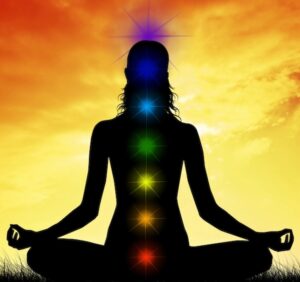
The chakra system evolves along with your personal growth and development. Starting with the Root Chakra or Muladhara and progressing upward to the Crown above the top of the head, the seven chakras chart the evolution of your subtle energy, mind, body, and spirit.
At any time, they express your degree of balance and imbalance. They reveal strengths and weaknesses as well as traces of traumas and developmental challenges.
Chakras Orient You Toward a Balanced Life and Better Health
When you learn about your chakra system you can better understand yourself and how you experience and show up in the world throughout your life.
For this reason, learning to attune yourself to your chakras and interpret what they can tell you about yourself is a valuable skill. This guide presents the basics of your first energy center.
Root Chakra Meaning
Other names for this energy center are Muladhara, First Chakra, Red Chakra, Root, and Root Center.
As with all of the chakras, the Root expresses a stage of human and spiritual growth. Because it’s in the first position, it represents birth and infancy.
The Root and Physicality
Not surprisingly, the focus is on stability, security, nourishment, and physical growth. Each chakra is associated with a layer of the aura. Logically, the Root is also associated with the first or physical layer.
This includes the structure, integrity, and integration of the human body in the form of bones and, ligaments, etc. Related to safety, security, and inner stillness are your Vagus Nerve and adrenal glands.
In addition, you develop a rudimentary spatial orientation and movement which includes the discovery of your limbs such as arms, hands, legs, feet, and toes. Eventually, you build an awareness of the other, who you need, and your ability to become upright and move.
Root imbalances manifest physically as fidgetiness, ungroundedness, lack of coordination, leg and foot pain, adrenal conditions, and a tendency to freeze under stress.
Emotional and Mental Attributes
A balanced Muladhara is expressed through safety and security; emotional and mental clarity; organized thinking; focus, steadiness, and followthrough; optimism and hopefulness; and resourcefulness.
An unbalanced Root Chakra is associated with fear, insecurity, vigilance, and financial worries, in addition to emotional vagueness and entanglement. Associated thoughts and beliefs can derive from a sense of scarcity, fear, lack of confidence, hopelessness, confusion and lack of focus, worry and anxiety, pessimism, and insensitivity toward your inner self.
Spiritual Attributes
A balanced Root Chakra expresses itself in clear beliefs and structured thinking; a good connection to the physical world; and a conscious connection to self, community, Earth, nature, and all that there is.
An unbalanced Muladhara infuses your spirituality with fear of the unknown and death; confusion concerning meaning and purpose; difficulty directing and channeling energy and making strong and intentional spiritual connections.
The Root is also the seat of Kundalini fire or energy. When Kundalini is awakened, you gain spiritual energy, access to greater truths, creativity, sensuality, and fulfillment.
Muladhara Meaning
Muladhara is a Sanskrit word. It’s another name for the Root Chakra. Muladhara means root support or foundation. It connotes solidity, stability, gravitational connection to Earth, and the facility of the physical human body to move and travel in space through the action of its legs and feet.
Where Is the Root Chakra?
 The Root Chakra location is at the bottom of your seven common energy centers. All the centers align vertically upward along the Central Light Column (Sushumna) that runs the length of the spine, making the Root the first center located at the base of both the spine and Shushumna.
The Root Chakra location is at the bottom of your seven common energy centers. All the centers align vertically upward along the Central Light Column (Sushumna) that runs the length of the spine, making the Root the first center located at the base of both the spine and Shushumna.
The red dot on the illustration indicates where the Muladhara is located. Its position underscores this center’s close association with the Earth and primacy in energetic, mind, body, and spirit development.
Root Chakra Color
All chakras have a distinct color. They range from red to purple like the light spectrum, increasing in frequency as the wavelengths shorten. Situated at the base of the Central Light Column (CLC), the Muladhara is red, hence the name Red Chakra. (See the image of the Muladhara sign of mandala).
The Root has the longest wavelength and is considered denser and more earth-like. It focuses on the physical level – the physical body and the physical world. Ascending the CLC to the Third Eye and Crown Chakras, the centers become more etheric and more spiritual.
Root Chakra Sign (Mandala)
 The sign for Muladhara is typically depicted with four lotus petals. The square is a sacred symbol representing solidity and stability. It also indicates the four directions: north, east, south, and west.
The sign for Muladhara is typically depicted with four lotus petals. The square is a sacred symbol representing solidity and stability. It also indicates the four directions: north, east, south, and west.
The triangle within the square signifies the orientation of this center’s energy. The flow of energy is drawn toward the Earth.
Another interpretation of the triangle points to the Root as the source of Kundalini energy which rises from this center to the Crown when awakened.
More First Chakra Attributes
Muladhara Chakra Sence
For Muladhara, its sense is the smell and the sense organ is the nose.
First Chakra Element
Chakras form a part of some Eastern medical traditions, with Ayurveda being the most prominent. An aspect of Ayurveda is the Five Element Theory, which states that everything is comprised of five elements – earth, water, fire, air, and ether. This includes your chakras, and each is dominated by one element in particular.
Muladhara is associated with the earth element, which is not surprising considering its close alignment with Planet Earth.
Root Chakra Planet
The Earth is the Root’s planet. Again, not surprising. However, Saturn exerts significant influence because it’s the Root’s ruling planet.
Muladhara Chakra Sound or Bija
The single-syllable sound associated with a chakra is called the bija. The specific sound or vibration balances and tones the chakra, and improves energy flows related to the corresponding chakra’s areas of influence (e.g., bones, emotional and mental clarity, sense of security).
Muladhara’s sacred bija is Lam. To balance or heal the Muladhara with the sound or vibration of the bija. Chant aloud or to yourself or hum. Alternatively, listen to Lam bija recordings; or music, tuning forks, or singing bowls that specifically treat the Root.
Root Chakra Crystals
Root Chakra crystals tend to be red in color or darker reds, browns, or blacks. Bloodroot, Tiger’s Eye, Garnet, Red Jasper, Carnelian, Hematite, and Black Tourmaline. You might note an overlap in Root and Sacral crystals such as Carnelian.
Arguably the best Root Chakra stones for grounding are obsidian, granite, and petrified wood, none of which is a crystal with a lattice structure of repeated three-dimensional atoms, molecules, or ions.
Muladhara Yoga Poses
Root Chakra yoga postures focus on attributes of the chakra such as grounding, stability, and moving forward. The poses emphasize structural integrity and balance, openness, and stretches. Some examples are (supta padangusthasana series), cobra poses (bhujangasana series), mountain, chair, and goddess poses (tadasana, utkatasana, and utkata konasana).
Chakra Interconnections
Despite the tendency for people to focus on specific chakras, the reality is they ideally work together and synergistically. Being comprised of energy and thus dynamic, they are constantly shifting in and out of an equilibrium. At times one or more chakras will disturb or dominate one or more of the others, creating imbalance and some form of dysfunction in your energy, auric field, and/or physical body.
Muladhara and the Earth Star Chakra
There are additional chakras beyond the common seven. The Soul Star and the Earth Star Chakras are two I commonly work with. However, there are several more depending on your beliefs and preferred model of the chakra system and healing.
The Muladhara and Vasundhara (Earth Star) have similarities. Both align closely with the Earth and nature. Each offers grounding, solidity, stability, and security. However, Vasundhara’s energy is more intense than that of Muladhara.
While Muladhara is oriented to the mind, body, and spirit of the human being, Vasundhara is oriented outwardly and globally creating connections to the community, all living beings, and the cosmos.
The Root and Sacral Chakra
Many people think sexuality is a root concept perhaps because of Root’s location at the groan. Alternatively, this energy center is the source of the Kundalini fire.
The Sacral Chakra is the actual center of sexuality and governs your sexual organs. Plus, it aligns with the Dantian or Hara or the center and source of your life force (Qi, Chi, Ki, or Prana).
All Other Energy Centers and the Muladhara
Because the Root is a source of structure and stability underlying the entire system, its imbalance can create instability within the whole system, disturb other chakras, and pull them out of balance. This is one reason grounding is fundamental to energy work, spiritual practice, and healing.
The Importance of Muladhara to Energy Work and Spiritual Practice
The depth and success of all energy and spiritual practices depend on the vessel. That’s you. When you connect to and work with energy or spirit, especially higher vibrations, you need to be adequately grounded. This means attending to your Muladhara, its balance and strength.
A tree is a good metaphor for the centrality of grounding to spiritual and energy work. A tree balances its root system below the soil with its crown above the surface.
The tree’s roots dig in more deeply and extensively to access nutrients and support (grounding), the growth and expansion of its habit upward and outward (spiritual growth and connection). So, when you intensify your grounding, you facilitate a more intense energy or spiritual connection no matter what type it is.
How to Heal Your Root Chakra
Know how to heal the Root Chakra naturally and with tools at your fingertips. First, you promote Muladhara balancing yourself. You can also seek assistance from an energy healer. Consider practicing these XX ways to become more grounded.
Add therapeutic and subtle properties of plants to create a grounded spiritual practice. Use Root Chakra essential oils to rebalance your Muladhara naturally. For additional ideas, see my blog post on balancing the Root to reduce overwhelm.
When lacking stability and groundedness, consider oils that specifically promote grounding such as Vetiver (Vetiver zizanoides), Altas Cedar (Cedrus altanica), Patchouli (Pogostemon cablin), and Petitgrain (Citrus aurantium).
In Conclusion
When you pay attention to your Mulahdara and engage in the appropriate self-care when needed, you’ll not only gain the benefit of a balanced energy center, but you’ll also give stability and support to your entire chakra system and your mind, body, and spirit.
When you balance your Root Chakra, you’ll feel more solid, stable, and grounded. You’ll likely feel more secure, and better resourced. You’ll also notice you have greater focus, assuredness, and competency in making decisions, solving problems, and sticking to your plans.
